The Clutch: A Defenders Guide to Clutching
Creating a clutching guide for Defenders is no easy task either. There are a lot of variables that you will have to deal with that are specific to your game. What I have done is put together a step-by-step guide of what I think is important to think about when going into a clutch situation.
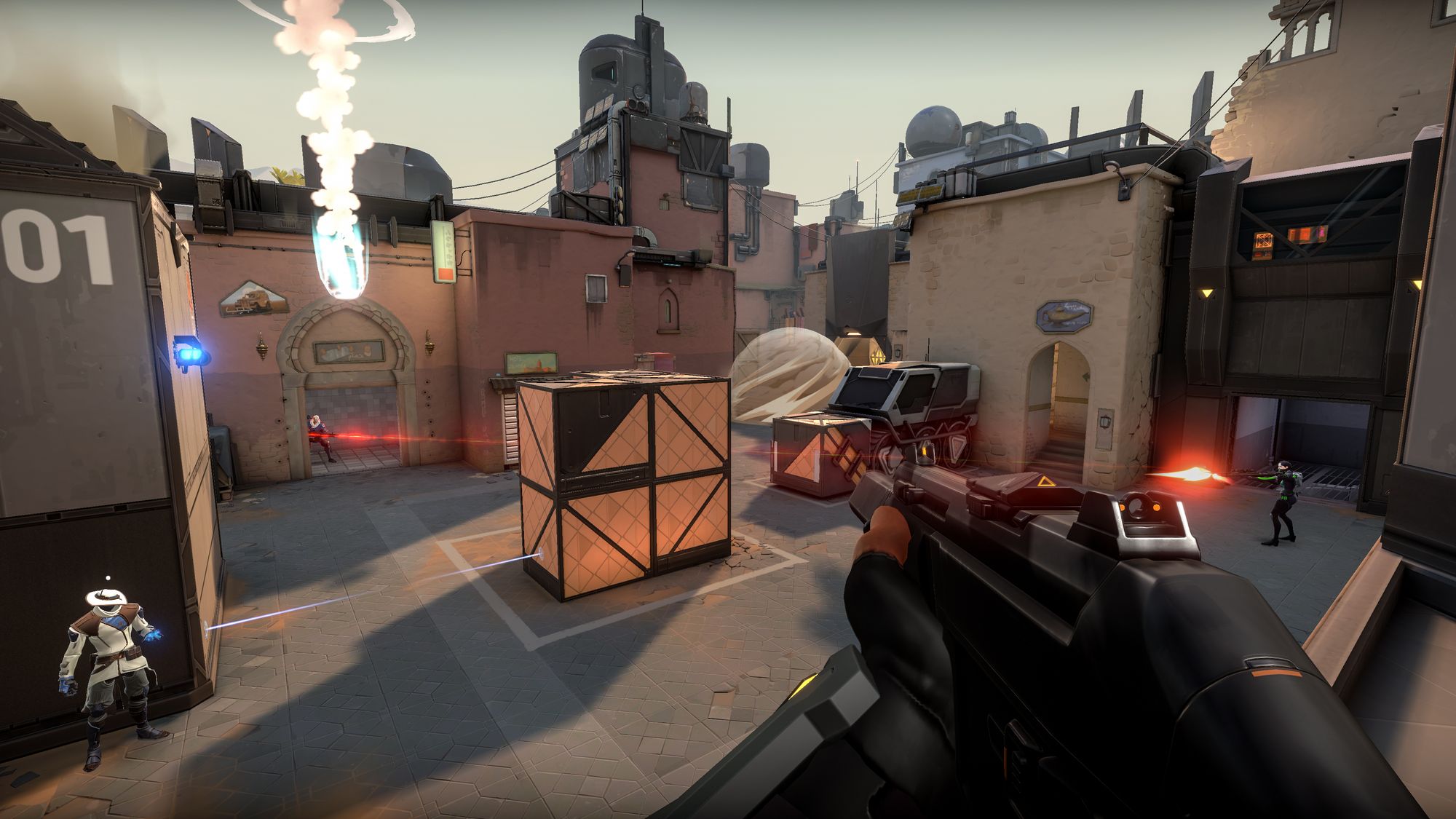
Clutching as a defender is no easy task. You could try to imagine the situation as a reversing of the tables. As a defender you start off holding a spike site and you sort of know the steps and events that will take place. Attackers are going to enter the spike site from a set of specific locations. If they are successful and take the spike site, the defenders now have to re-take the spike site.
The main difference, and really the reason it is so hard, is that as a Defenders trying to retake the site, you’re at a disadvantage. Attackers can be anywhere in the spike site. They can be holding an infinite amount of angles, even angles that don’t make sense. Information will be your best guide when you are trying to locate possible positions but it will only take you so far.
Creating a clutching guide for Defenders is no easy task either. There are a lot of variables that you will have to deal with that are specific to your game. What I have done is put together a step-by-step guide of what I think is important to think about when going into a clutch situation. This guide will cover the following:
1. Over-rotating /Rotating too early – There are many issues to dive into here. The gist of this concept is that by over-rotating you create a problem for yourself and your team. You have created a potential hole in your defenses which an attacker can sneak into and cut off your rotates from fakes.
2. Saving, Exits or Going for it – I brought this up earlier, there are many issues that will be specific for your game. I will go through each argument one at a time and hopefully give you some tools to help you decide if clutching is the best idea.
3. Information Needed for Clutching – For me, this concept has to be explained in ever guide. Information is what is going to help you win rounds.
4. Eliminating Angles – Once you find yourself in the clutch situation, this will help create one vs. one situations and make it easier for you to clutch the round.
5. Getting into the Mind of Your Opponent – Try to understand what your opponent is thinking. Does the opponent expect you to come from a certain location? If so, make a decision whether coming from that location is your best course of action.
6. What to do in 1v1 Situations – This chapter will start off as a summary of what you have learned and how to use all of the concepts to your advantage.
7. Bomb Tapping – Very simple concept but I will try to dive into what your opponent expects when you tap the bomb and how you can use that to your advantage as well.
8. Creating Distractions – Distractions can be very powerful in a clutch situation and can be used to deceive your opponent.
Once you complete the guide, I hope it will give you some ideas on how to approach one of the hardest situations in Valorant.
1. Over-Rotation
Over-rotation occurs when Defenders make a commitment to a bombsite when there is barely enough information to support the number of defenders holding that bombsite.
Why is this bad? When you rotate too early you create holes in your defenses that lurkers will happily walk through. This can cause a lot of problems for your remaining teammates who depend on you to hold an entrance to a bombsite.
Let's say that you are holding catwalk on Ascent and there is a call for B Spike Site. Maybe the Defenders holding the B site only heard footsteps or maybe go flashed. By rotating, you have essentially have given up catwlak and dedicated your rifle to helping your teammates at B. But let's say that there is a teammate who is playing inside A who is also rotating to help the teammates at B.
But when you gave up catwalk, there was a lost Attacker who wandered (or lurked) on to catwalk and peeked just as you left and your teammate was rounding the corner. Your teammate is eliminated. Now what?
This is not even to mention the possibility that you may have been faked out and the Attackers2 really planned on taking the other spike site.
So how do you solve the over-rotation problem? Well you can’t really. Your teammates have to come through for you. You have to realize that your teammates are just extensions of yourself. You rely on them for information. This is only achieved through good communication.
Good communication is a skill. This is often talked about but rarely explained. In competitive video games, good communication is really getting as much information to your teammates in the shortest amount of time possible. To practice good communication, shorten your sentences.
Here's a situation that happens too often. Your teammate opens up voice chat and tells your teammates a story about how he might have heard footsteps but he doesn’t really know because his cat was chasing a fly on the wall and did a backflip and he wasn't really paying attention.
Cut the story out. Simply say, “Possibly 1 B, heard footsteps.”
2. Saving, Exits or Clutch
Anytime you lose control of a spike site as a Defender you have to make this decision, “Should I save, go for exits or is this situation clutchable?”
At the lower levels of competitive play, this decision is often completely dismissed and Defenders just go for it everytime. But this isn't always the correct choice.
“Saving” refers to saving the equipment you purchased at the beginning of the round. You do this by finding a place to hide where you don’t believe the Attackers will find you.
“Exits” is often referred to as “Going for Exits” which means that you are going to find a place or path where you believe Attackers will be exiting the bombsite. You will hide and wait to kill one or multiple opponents which will force the opponent/s to repurchase their guns next round.
Lastly, should you try to clutch?
Each option described will have different arguments for why you should or should not choose that particular option (and your teammates might get mad at you if they think you picked the wrong one, but ignore them.) And in the next couple of chapters I will give you the argument for why you should either save, get exits or try to clutch.
The Argument for Saving
Now this argument will be hard to stomach for some people. Saving in matchmaking will almost always come with some sort of flame unless it’s a one vs. five and you have 10hp. But saving is almost always a smart choice.
It all comes down to money and risk. Think of it as an equation for whether you should be brave or live to fight another day. But before you run into a situation, hit your TAB button or whatever you have bound to be your scoreboard. Look at your money and your teammates’ money. Remember those numbers.
Now a quick economics lesson in Valorant. The cost of an rifle will run you $2900. An Operator is $5000. For Head Armor, whether you believe in it or not, will cost you $1000.
If your main role in game is a "rifler" or a person who is primarily uses rifles, it is going to cost you $3900 just for a gun and armor. An Operator, you are looking at $6000.
Now compare that to the money you receive each round. Here is the break down for what you receive as a base amount if you lose:
1. First Loss -$1900
2. Second Loss- $2400
3. Third Loss - $2900
As you can see you get $1900 + ($500 multiplied by the number of losses in a row)
To justify going for it and running the risk of dying, you need to have enough money to put yourself back in the situation you were in before you died.
If you just had the basics and this is your first loss, you need to have either $2000. For an AWP you need to have $4900. The math scales up the more you lose and it becomes cheaper to “go for it.”
You can find out the amount you need by subtracting $1900 + ($500 multiplied by the number of losses in a row) from your total cost of your beginning round purchase.
We now have the money side explained; let’s shift our focus to the risk portion of the equation. Here, we need to start by looking at what the situation you are about to face. Ask yourself the following:
1. How much money do I have left?
2. How much money do my teammates have?
3. How many terrorists are left?
4. How many teammates do I have left?
5. Is the spike site hard to retake?
6. Do I have any flashes or grenades to help me retake the site?
7. Are the terrorists expecting me to retake the site?
8. Do I know if there are any Attacker flanking and trying to attack while I retake the site?
You should notice how the further you go down the list of questions, the more you feel in your gut that maybe saving is the better option. Ask yourself, can I make more of an impact on the next round for myself and my teammates if I have a better gun and armor? That answer is almost always yes.
So… what are you waiting for? Find a good hiding spot!
The Argument for Exit Killing
Exit killing require you to think about your money and whether or not you are willing to risk losing your gun in order to get guns out of your opponent’s hands. It is a combination of saving your gun and killing your opponent. It is not getting into an aim battle with your opponent. There should be little chance for your opponent to kill you when you are going for exit kills. This is a very important point to this concept that's worth repeating twice. There should be little chance for your opponent to kill you when you are going for exit kills. This means hiding behind boxes, hiding in corners and it certainly does not mean standing in the middle of a hallway taking 2v1s or even 1v1s.
Let’s take a look at the economics of going for exit kills.
By going for exits, you are conceding the round to the Attackers. That means all the Terrorists receive $3000 from the bomb’s explosion.
The cost of head armor and an ak-47 is $3900. Now if you’re looking at the math you should notice that $900 is what they would need to rebuy the next round. Just a reminder, $3900 is just the basics, only an ak-47 and head armor. Often Attackers are forced to buy abilities to get access to spike sites which increases the costs of buy rounds for Attackers. When making the decision to go for exit kills you are attacking the Attacker's money and decreasing the benefit of the spike explosion.
From the money alone, this makes going for exits somewhat lucrative prospect if you know the opponent is low on money.
If the money doesn’t entice you, maybe this will. By going for exits you essential are catching the opposing team by surprise.
In a previous chapter we talked about how hard it is for Defenders to retake spike sites because Attackers can be holding an infinite amount of angles. Well going for exits flips that concept on the Attackers. They are forced to contend with almost every angle to save their guns. You can be anywhere on the map and this gives you a huge advantage.
Going for exits is always a controversial call. One common mistake that people make is when the Defenders needs to save his gun, but goes for exits and after an extensive aim battle, the Defender dies. This should be an obvious mistake but for some reason it’s not.
The reason this is a mistake can be a number of things. First, you need to make the choice ahead of time whether you are saving or you are going for exits. By making this decision, it will help you determine where you are going to wait for the opponent. You want to hold angles where you will not get into an aim battle with your opponent.
Second, you need to know what gun you are saving. This will determine whether you are close or farther from the exit point. It will also help you decide if you are going to hold a tight angle vs. a looser angle.
If you are saving an automatic rifle such as a Phantom or a Vandal, you will want to hold a closer angle. You will also want to make sure you are aiming around the chest or head level. You want to take down the opponent as fast as possible. In addition, it can be either a tight angle (which provides maximum cover if you miss) or a looser angle where you are trying to maximize surprise over cover.
Saving an OP is a little different. People may disagree with me on this but here is my concept and my logic behind going for exits with an OP.
An OP is one of the most expensive commonly used guns of the game. At $5000, it can make a huge impact on the next round. The AWP kills in one hit unless you hit one of the legs of the Attacker. This combination of cost and damage makes going for exit kills controversial.
My philosophy about going for exits with an OP is you get one shot at it. If you miss, you don’t go back for a second shot. The reason for this is you have a maximum surprise element which makes it safe to take the first shot. However, going back for a second shot is greedy and opens yourself up to an aim battle. If you are going for exits, you're trying to save your gun. You are not trying to get into an aim battle. Aim battles are a big no-no.
In the end, if you think you have enough money to buy next round and you believe you can find angle which will surprise the exiting Terrorists, I say go for it.
The Argument for Going For It!
When deciding you are going to attempt the clutch play, you have ruled out the possibility of saving and exit kills. Situations where this decision is acceptable are but not limited to:
1. You have the money to replace your gun and armor.
2. You are desperate for rounds or it is the last round of the half.
3. You have a teammate or teammates that are going for it and are prepared to retake the spike site together.
4. You have communicated to your teammates your plans.
From this point forward, I am going to assume that it you vs. “x” amount of attackers. Many of the concepts described can be applied when you and a teammate are retaking a bombsite. However for simplicity, the concepts are better described assuming you are alone.
Alright! Let’s take the plunge and go for it.
The Information You Will Need
1. Where’s the Spike?
The very first piece of information that you need is the location of the spike. If the spike hasn’t been seen there is no point in rotating to help another bombsite. Remember your holding your original position for a reason. Unless you are with a teammate who can cover the position while you leave, hold fast. (Yarrrggh!)
If you know the bomb is down somewhere on the map then this may change the situation.
A one vs. “x” with the bomb down somewhere other than a bombsite opens up possibilities. You have to make the decision to either move towards the bomb to stop the Attackers from picking it up or hold a bombsite and wait.
Trying to hold on to a downed bomb can be a difficult task and even more difficult to describe how to clutch in those situations. There are too many variables to consider. For the purposes of this guide, I want you to wait or make your way to the spike site closest to the spike.
2. How many Attackers are left?
Second you’re going to want to know how many Attackers are left. Press your TAB button and figure this out quickly. Remember if you’re facing a one vs. four or five, reconsider possibly saving or going for exits.
3. Do your teammates know the location of any Attackers in the spike site?
This one is probably the most important of the list of information you need. If you know the location of the Attackers your life is infinitely easier. You will be able to shut down angles and separate the Terrorists if you know where they are. So make sure you ask your teammates if they have any information to share before transferring to their spike site.
4. How much time do you have left?
Once the spike is planted you have 45 seconds to defuse it. Usually you will start to transfer to the spike site once you have heard the spike go down.
Depending on the map it can take you anywhere from 5-15 seconds to get to the spike site. That leaves you with roughly 20-25 seconds to find and kill the enemy, as you need time to defuse the spike.
Keep all that in mind as it will take you time to find out where the Atatckers are and eliminate them.
5. Is the opposing team saving? Do they have upgraded guns? If so, what guns do they have?
This is the last piece of information you should have when approaching a clutch situation. What guns do the Attackers have? Was a gun picked off the body of your teammate? Does one of the Attackers have an OP? All of this is important information to have. With this information you can better determine the potential angles they may be holding.
Now that we have pieced together this information, we can now approach the bombsite. It’s go time!
Eliminating Angles
Eliminating angles is one of those higher level concepts that you might do without knowing that you’re actually doing it. It’s a fairly easy concept to explain, in the game of Valorant you have objects to hide behind; when you peek out from that object, what you see is a viewing angle.
Your viewing angle can be tight, with only a little portion of your character exposed. Or your angle can be loose, where a majority of your character is exposed. Think of viewing angles as alleyways.
By eliminating angles you have to imagine or know the angles your opponent is holding. The purpose of eliminating angles is to create situations where you are focusing on one opponent at a time. Thus, increasing your chances of winning the round because you're not taking fire from multiple angles.
Here's an example of a situation where eliminating angles is required. Here is the A site on Split.
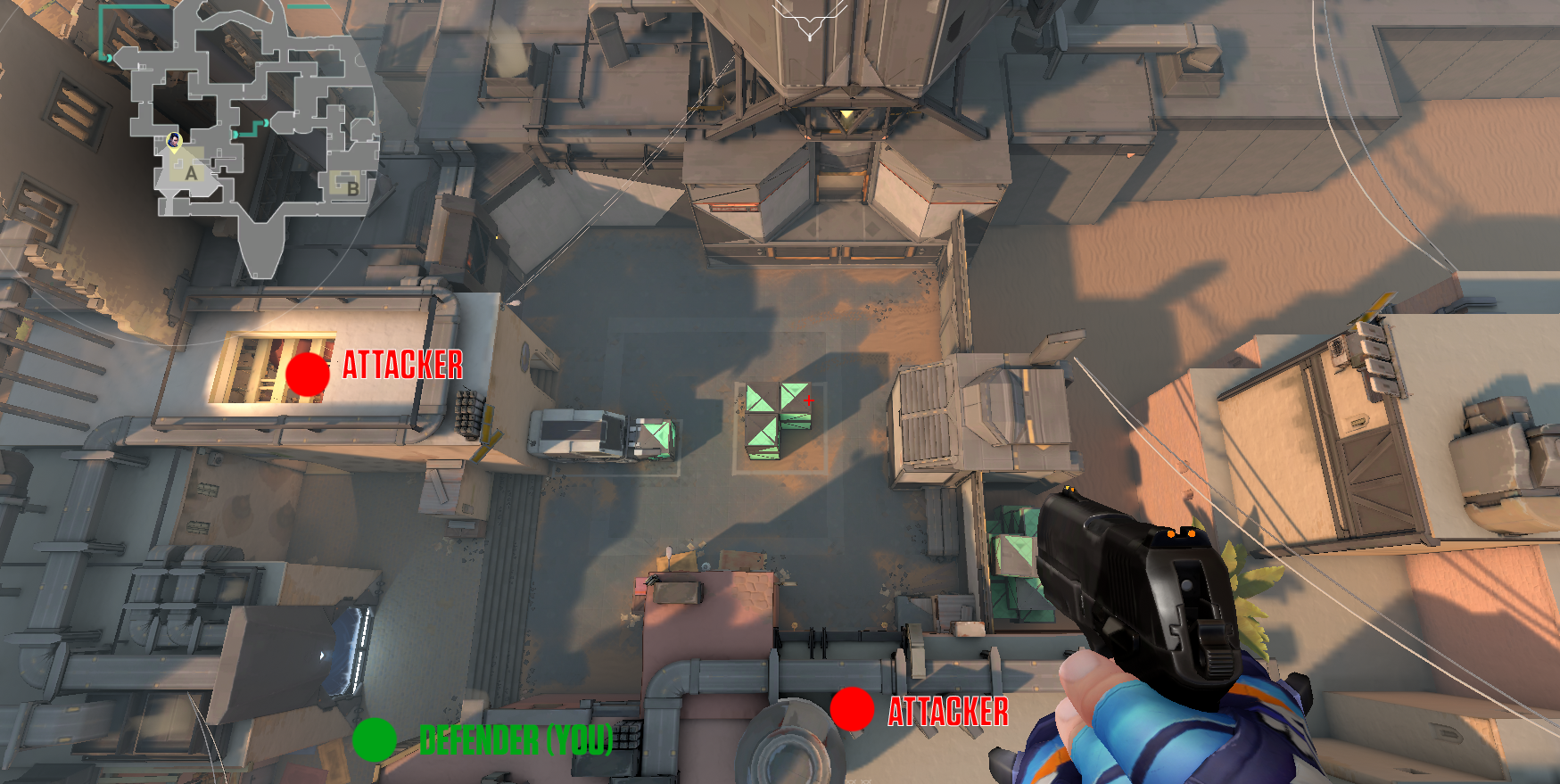
Here’s a one vs. “x” situation. There are two opponents remaining and you have to defuse the spike. The Attackers have setup a deadly crossfire for holding the site. Attackers are red and you’re the little green guy on short. How do you engage one opponent at a time?
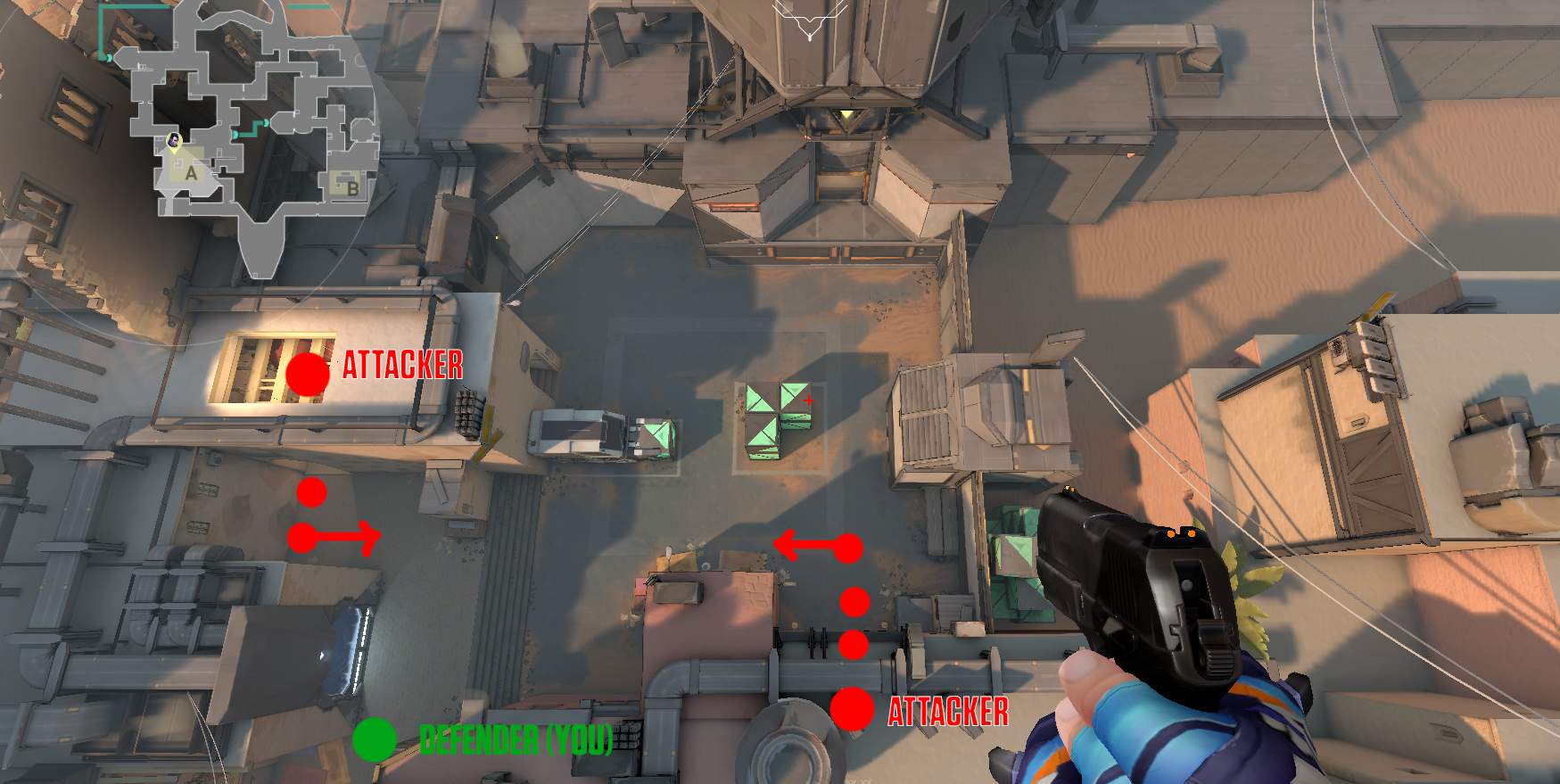
You isolate one attacker and focus on another. In the picture above, you'll find that both attackers are looking towards you in a crossfire. How do you separate these two? Well Valorant has given you some tools and taken some away. When I originally wrote this article for CSGO, there were more boxes and more of a focus on isolating enemies using the environment.
However, in Valorant, we've been given abilities. Let's pretend you are Jett. Knowing that this is the case, you have to exploit their fields of vision. You do so by throwing down her Cloudbursts.
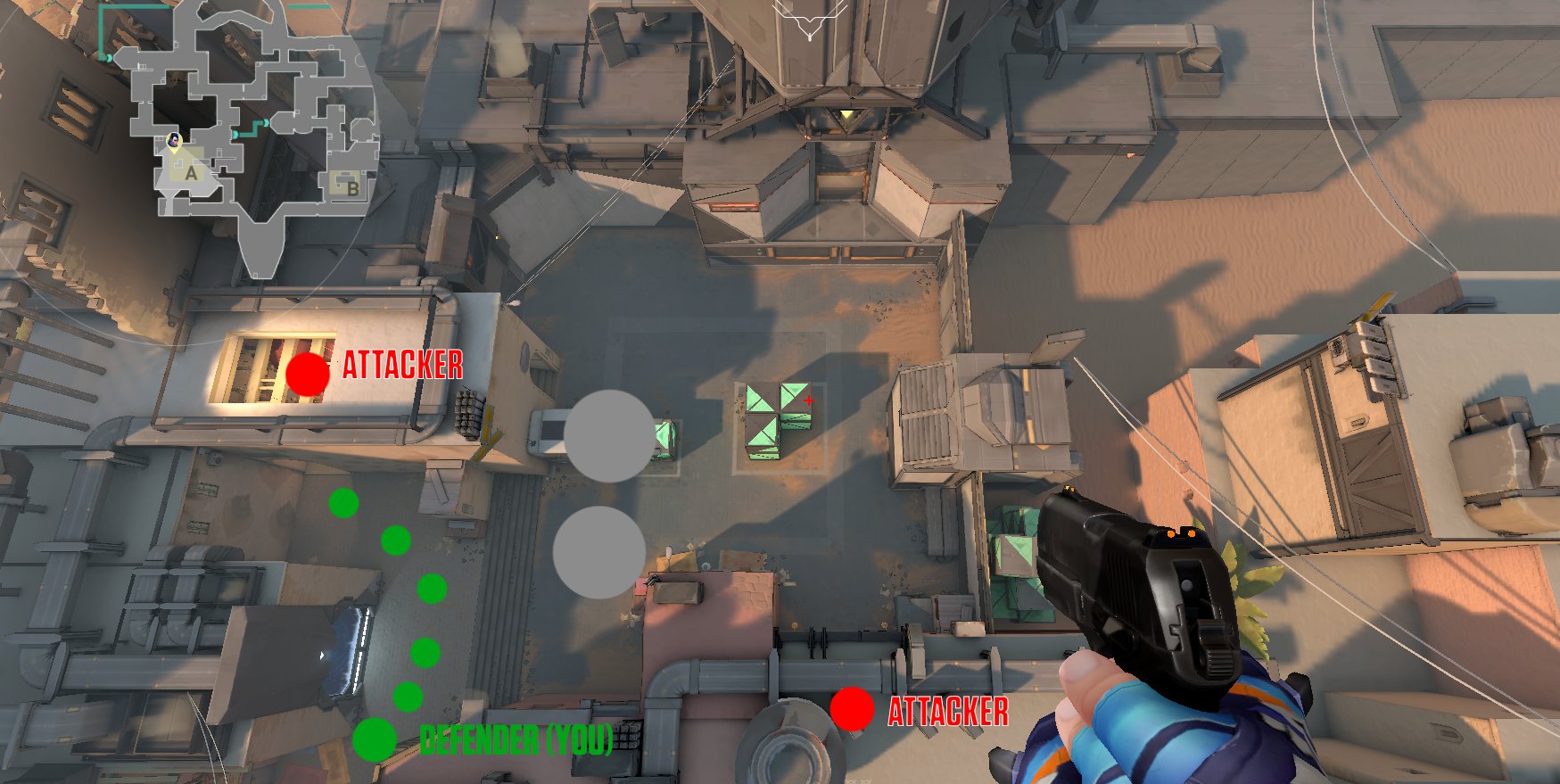
Using the CloudBursts for cover, you negotiate your way into U-Haul. This allows you to engage target 1 in a one vs. one situation. This increases your chances of winning the situation. If you are able to kill Attacker 1, you now have one more one vs. one to finish before you win. Using the boxes again to your advantage you can quick-peek the opponent in bathrooms and win the round.
Learning angles and approaches in Valorant is just as important as learning to aim. Take some time to run around a map and make mental notes of what an angle can see and can’t see.
Something you may be asking yourself is “What if there are no convenient abilities to use?” Well then you have to be creative.

Here is the situation again.

What you are going to do is throw a CloudBurst that eliminates the viewing angle of the player at behind boxes at car.
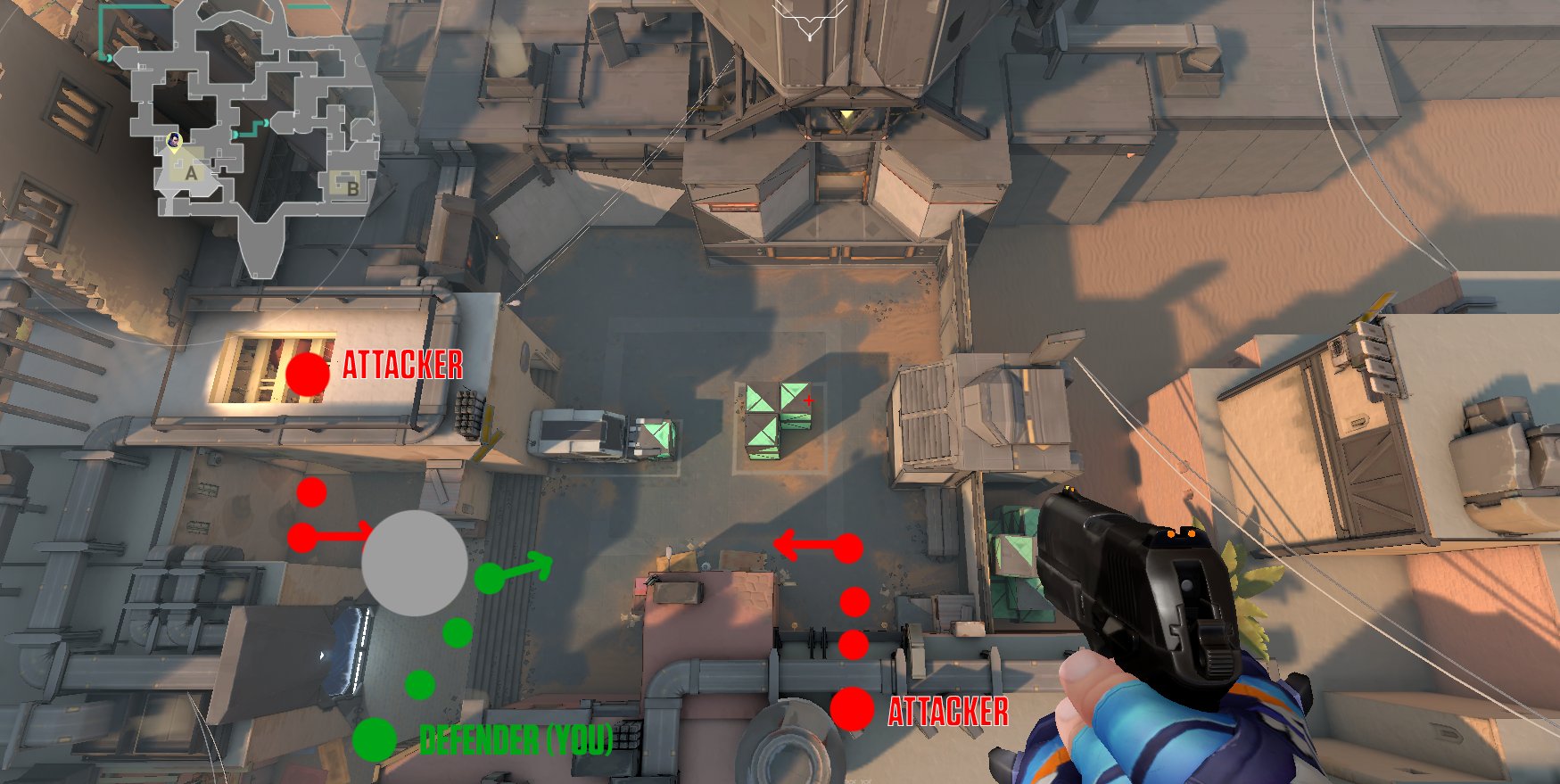
Then move in front of the smoke and engage in a one vs. one with the opponent in bathroom. After that engagement is over, you can turn and engage the player behind at U-Haul.
Meta: Defining the Mental Movie of Valorant
How do you get into the mind of your opponent? This isn’t a very easy task as you know each opponent is different. What you need to understand is that there is a Meta that plays out in Valorant. It’s almost an expectation of how things SHOULD play out. Like an old story you have heard a thousand times, you expect a certain chain of events to occur. Our use of Meta for this guide will help you make assumptions and allow you a glimpse into the mind of your opponent.
Now this isn’t the easiest concept to grasp.
Let me take a little more time to explain and give you an example.
Imagine you’re playing Split as an Attacker. Your team calls out a 2-3 split for B heaven. Two people are supposed to go B garage and three teammates are going to go mid to B Heaven. The current “meta” says that there will either be either 2 Defenders heaven or one Defender at the B site depending on the setup. But you expect at least two players. But the knowledge that there are players in bombsite B isn’t where the idea of meta ends.
Now, how this strategy should play out is that either the Attacker teammates who are going Mid to Heaven and will engage the enemy. This causes a split in the Defender's defense. This forces the Defender to engage at heaven or fall back to B pillar.
Once the Defenders are killed at B Heaven, this allows the remaining Attackers players to pinch and help their teammates attacking the other entrance.
And this story that has played out millions of times on Split becomes an expectation of events that should occur. If they didn’t, you would feel that something went wrong. Both sides expect this turn of events to happen. This is the meta everyone talks about.
Meta: Exploiting the Mind of Your Opponent
With this in mind, you can use the Meta to your advantage. There two ways to exploit the established expectations in your opponent’s mind. First, don’t follow the Meta and go against it. Second, play with the timing of the Meta. These two tools can help confuse and ultimately conquer your opponent.
If you don't follow the meta, you are changing the way the story plays out. It’s a very simple strategy to apply in a 1v1 situation. And you have seen people do this before. For example, when a defender is in a 1v1 situation and instead of going for the kill then defuse the spike, the defender just defuses and wins the round.
On top of the expectation of certain events playing out, there is an expectation of timing as well. After playing so many games you get a feel for how long something should take.
An example would be imagine you’re a defender and you have spike down. After a minor gun battle, the opponent picks up the spike and you know this happened.
Now after a couple of seconds, you expect him to plant in the closest spike site. But it takes longer. And time keeps going by and there is no spike plant. Usually this lapse of time is a cue that the opponent has taken the bomb and run to the other spike site. That feeling you get that this is taking longer is your brain expecting a series of events to occur that didn’t occur.
Well you can exploit this timing Meta as well. You want to set off those alarms in your opponents mind. It forces the opponents hand to make an action. An extra second before peeking a corner has an effect on your opponent especially in a 1v1 situation where your opponent is faced with multiple angles to cover.
1v1 Spike Plant Scenario
So here we are. You have made it into a 1v1 situation. Whether this was because of your teammates or you eliminated four of the opponents and you’re a couple seconds away from an ace, it doesn’t matter. You have come to the final boss of Valorant.
Before we start, let’s talk about nerves. A 1v1 can be one of the most nerve-wracking situations of Valorant. You have the pressure of winning the round and the pressure of knowing four other teammates are watching you and depending on you to win the round. Now being nervous is not always a bad thing. It lets you know you’re in the moment and there are lots of things you must tackle ahead of you. However, you can’t let this nervousness be debilitating. You still need to THINK and run down the check list of thing I mentioned above in this guide.
If your teammates have killed all the opponents except one, it’s likely that it is not at the spike site you’re covering. This makes the task harder. You are going into a situation of unknowns. You’re going to want to reach out to your teammates and have them fill in some gaps. Where’s the bomb? Where was the last location of the last terrorist? How much time do you have left? Is it a save round or does your opponent have an upgraded gun?
Those are the basics. If you know where the opponent is, are there any angles you know of that you will have to worry about?
Once you have all that information, you should be arriving at the spike site.
Now we want to get into the mind of our opponent before we start the process of clearing potential attacker angles. Take a second to ask yourself “What is the attacker expecting to happen?” Well when we talked about the Meta we said there were two ways to exploit our opponent. Going against the meta and messing with the timing of the Meta. This is where you as the Defender get to be creative. How do you want to approach the situation? Are you going to follow the meta and approach the bombsite like the attacker expects then mess with the timing? Or are you going to try to go against the meta and capitalize on the surprise element of your approach? Remember timing plays a huge role in Valorant so if you take too long it will trigger your opponent to think differently.
Before we get to clearing angles, I think this should go without mentioning but “silence is golden.” You need to be aware that sound will give away your position. You should always know at what point an opponent will hear your footsteps. This will take some learning by either experience or getting a teammate to go through the process of running around for you.
The next task you have is clearing potential angles. Clearing angles means that you are taking the time to check every possible hiding position as you get closer to the spike. Now depending on your skill level this can be a slow or quicker than most. However, you need to take your time. There has been countless times where I have gone too fast and forgot to check an angle and died. If you don’t know where the last terrorist is this process is tedious.
There are shortcuts, but remember shortcuts can always hurt you if you’re not careful. These shortcuts relate to position of the bomb plant. A good example of this takes place on Split.
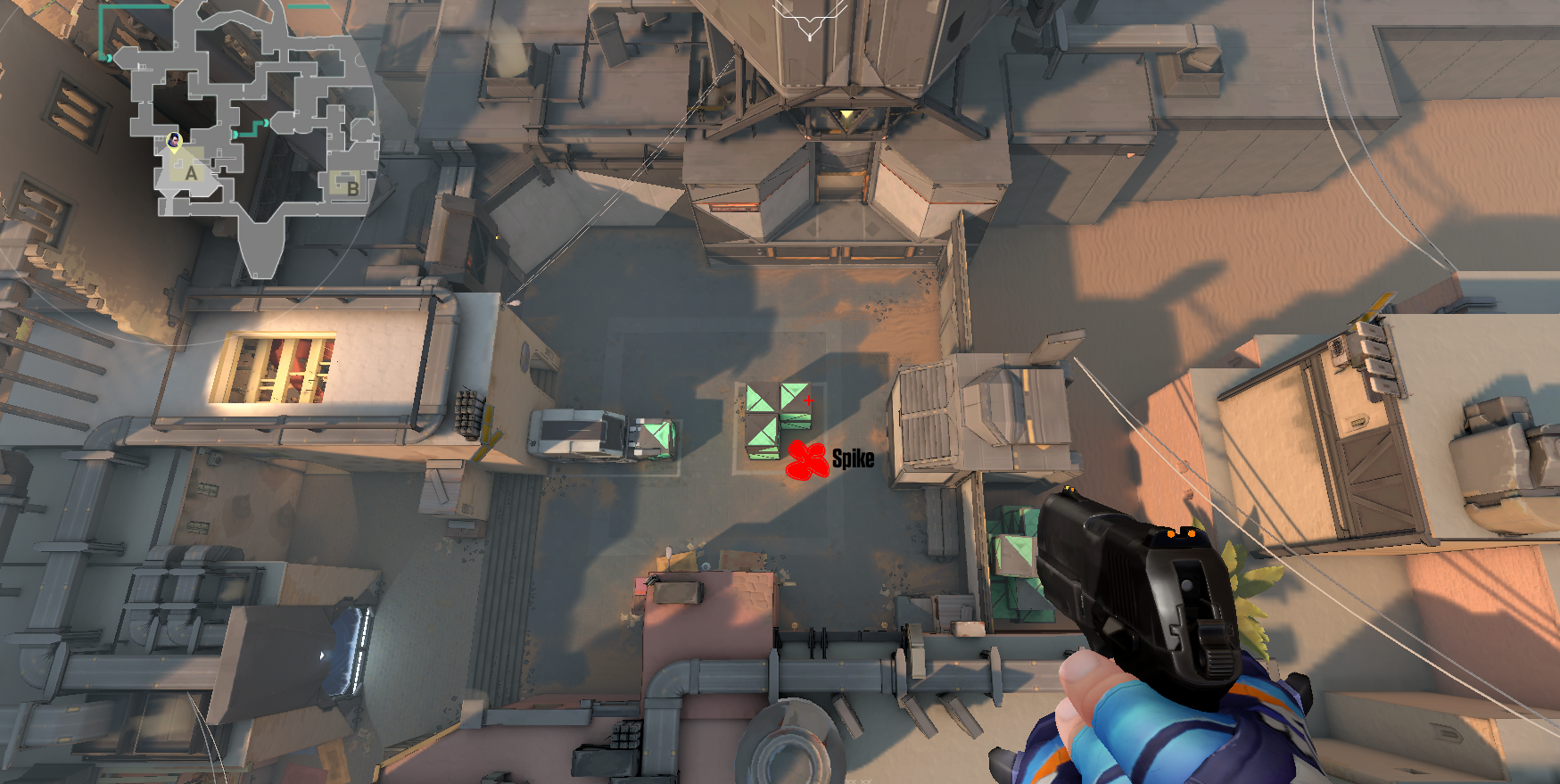
Here is the A site on Split. The "X" refers to where the spike is planted. Now if you’re coming from B site, this particular spike plant should tell you some things. Let’s first think about the Meta behind this bomb plant.
When an Attacker plants the bomb in a default spot on Split there are a couple of places they SHOULD hide. (Emphasis on SHOULD because remember our plan when it comes to the meta, we’re trying to break it. But for the purpose of this example, let’s not think about that for a second.) We say should because there is a certain amount of time it takes for you to rotate. You opponent-attacker knows this, so if he’s going to hide then it will take time to get to a hiding spot.
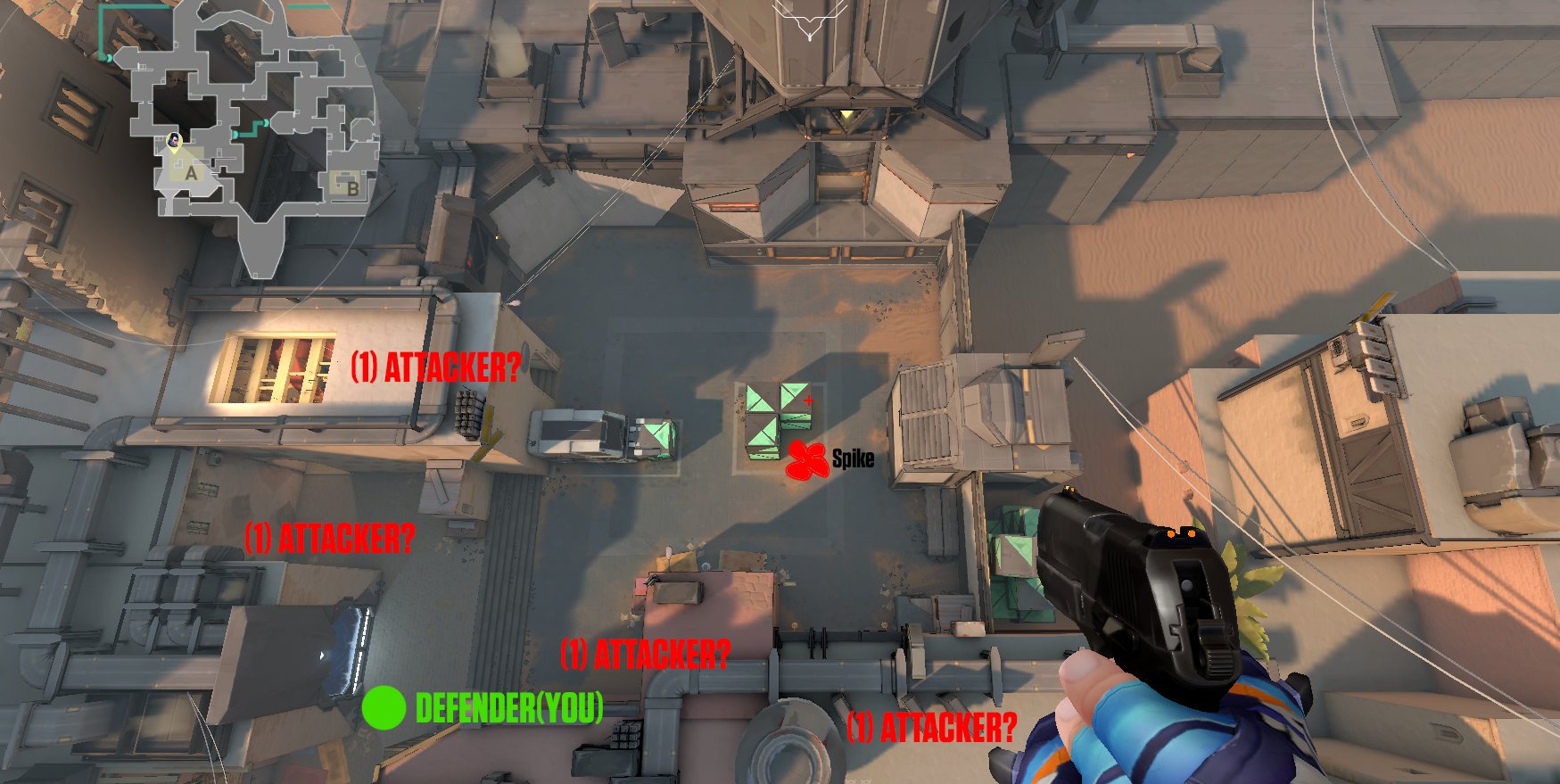
These spots are the most common hiding spots (the meta) for a default spike plant. You can narrow this down further depending on the timing of your rotation. If you got to site “A” just as the attacker planted it will be hard for him to get into spots closer to you. If you get there late, it’s possible he could be in all spots.
Your goal should be a process of elimination when clearing angles. The process is tedious because you need to be sure your opponent is not hiding in the spot you checked so you can make progress and move closer to the spike .Let's go over one more example of when the bomb is planted in the middle of the site of "A."
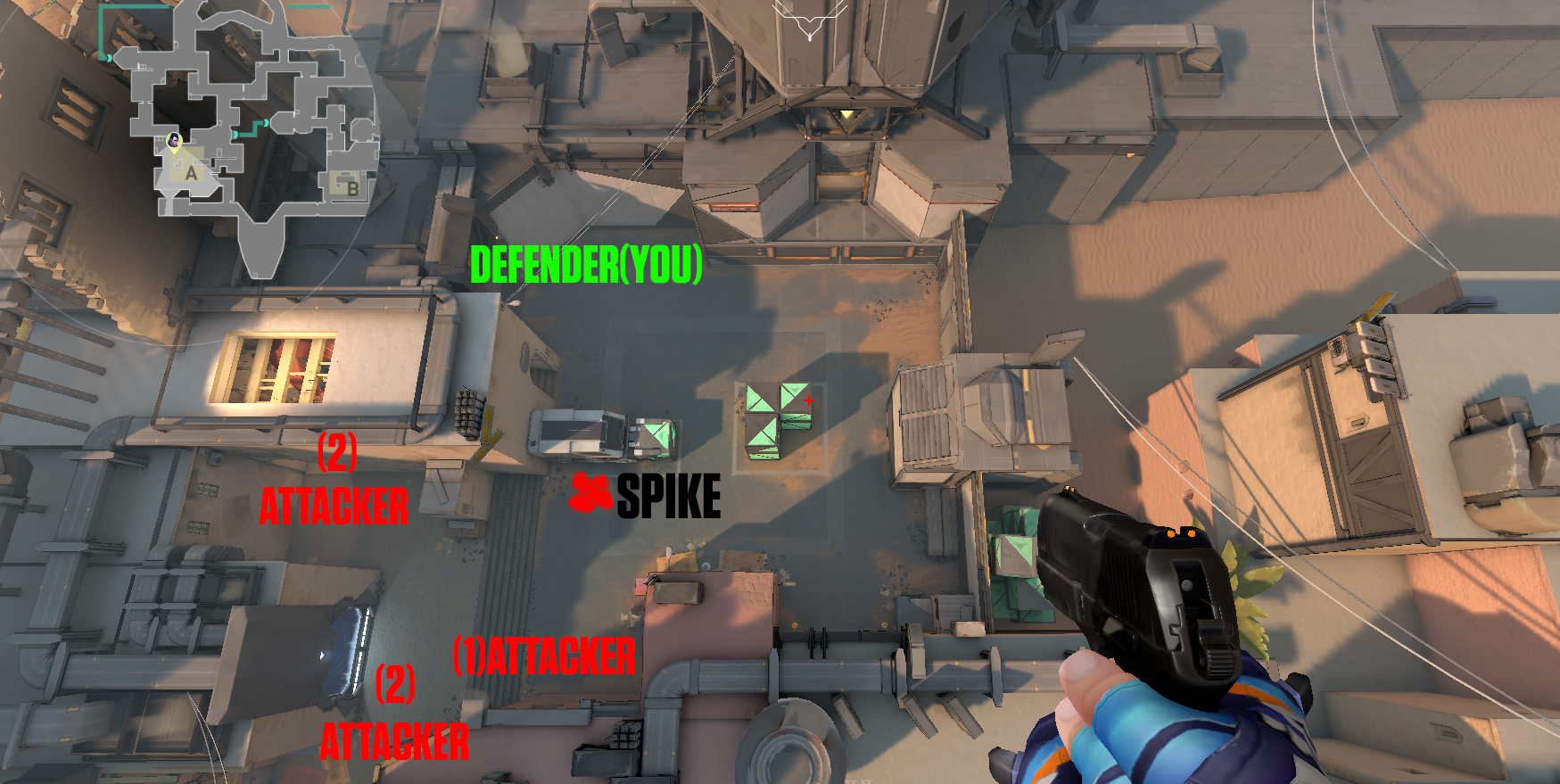
Now this tends to be a little more difficult. You really have to know how much time the opponent had after the bomb was planted. As you can see, according to the meta, the opponent can be in site, in U-Haul or short. Now if you just got there when the spike was planted, these are the most common spot right? He won’t have enough time to make it to closer to you because he has to cross your field of vision to get to bathroom or anywhere thats on the short side of A.
The point here is that timing really matters when you make your rotation. If you give the opponent too much time, he can really be anywhere.
Spike Tapping
The idea of “spike tapping” has its origins probably from the first time someone planted a bomb and when the Defender went to defuse it made a noise. The idea behind spike tapping is to create the illusion that you are defusing the spike when you’re not. In the beginning, I’m sure it worked all the time. I’m sure you can imagine all these infant Valorant minds just being utterly confused when they realized the spike wasn’t being defused.
These days this trick doesn’t exactly work all the time. Many times people won’t even react to the first defuse. This leads to Defenders often just going for it and running the risk of getting killed.
Lucky for you, we at this point we understand the concept of meta and how it plays out. We know that depending on your level of play, terrorists are expecting some sort of bomb tapping strategy. So how can we take advantage of that? Let’s talk about four methods of Spike Tapping.
Well the first method was already discussed above. We can simply just go for the defuse on the first spike tap.
Secondly, another strategy that is often employed is the spike tap and then a second spike tap shortly after. This gives the terrorist the impression that you have looked for him and given up. Since they believe that you have looked for them, there is a greater chance that he believes that this second defuse is the real one.
Thirdly, a meta that is currently evolving is the usage of smokes to defuse. You throw a smoke down and then go for the defuse in the smoke. This works sometimes because the smokes creates an opaque barrier and the attacker can’t determine which side of the spike you’re on. So he panic sprays and hopes to hit you. Now this strategy is used on maps where the attacker is forced to hide and take their vision off the bomb.
Lastly, a strategy that takes advantage of the current smoke grenade meta. In this scenario you use the smoke as the trigger for the terrorist to give up his position. You pop the smoke on the bomb then keeping outside of the smoke range, you peek the attacker and go for the kill. This particular strategy isn’t used very often so you might find a lot of success here.
Creating Distractions
In all 1v1 situations, you want your opponent to make the first move. However, there are times where the attacker just won’t make the first move. This usually happens with the most experienced players. Thus we have to find another way to give us the upper hand. This concept builds off the spike-tapping idea.
What we want to accomplish is to create a distraction or a deception that sticks in the mind of your opponent. Throwing an ability might be a choice. Not necessarily for the noise it makes, but for the split second that the opponent has to realize what is going on. Or even making a footstep of any type can give your opponent information that you can use to your advantage.
In all of these situations, you’re attempting to take advantage of the fact that your opponent thinks they know what is going to happen. All you’re doing is giving them the bait and letting them run with it. There are many other ways to take advantage of these assumptions, just take some time to think some up and they will bring you success.
You Won! Now what?!
This portion of the guide is a reminder not to fall for the tricks you’ve learned in this guide. Your opponents are not stupid when they fall for your tricks. You know they know something about the game and you’re taking advantage of that knowledge. At some point you will run into opponents like you who are thinking a couple steps ahead. In those situations you just flip the meta and go back to playing like you haven’t got a clue.
Also, you need to realize that when you use a trick, you have to expect that the opponent will learn from his or her mistake. Trying to use the same smoke trick or route when you just used it a couple rounds before is going to lose you the round. If you watch top players in Europe, you will notice that they never protect a bombsite the same way twice. They are always rotating positions. This happens because they respect their opponents ability to learn.
In the end, you will realize what you really are doing in clutch situations is showing your opponent that they’re playing checkers and you’re playing chess. They will think there is just one way of doing things. They are used to the Meta. When in fact that’s not the case at all, there is as infinite number of ways to approach any situation in Valorant. Once you grasp this concept, this guide becomes useless and you can call yourself an experienced Valorant player.
Conclusion
This guide took a really long time to put together. I know a lot of players will ridicule this guide as being basic or a waste of time. I got that in my last guide.
But I hope you realize that many of these concepts are never explained. You are just “expected” to know them. Well unfortunately for these people, this guide does exist and the people who are new are going to be able to progress faster than the people who believe this guide to be basic.
In addition, I’m an older counter-strike player with roots in 1.6 and all these concepts are historic. What I’m really trying to do with these guides is to pass on my knowledge to younger generations of players who are just starting out. My days of Counter-Strike are numbered and hopefully yours are not.